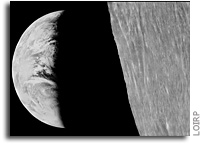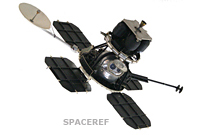 Dennis Wingo Status, end of day, December 30, 2013.Well, I finished through W4-078 today. Got 11 tapes done so that’s pretty good. I am coming in tomorrow to get as many done as I can.
Dennis Wingo Status, end of day, December 30, 2013.Well, I finished through W4-078 today. Got 11 tapes done so that’s pretty good. I am coming in tomorrow to get as many done as I can.
Lots of spacecraft problems on these images…..
Working today. Playing tape W4-074 right now. Hope to get to 80 today but we will see. I am going to get to the end of Woomera tapes by Friday and start immediately on the Goldstone tapes.
Woomera ends at W4-107 I think…
Research Data Disappears Fast

Scientists losing data at a rapid rate, Nature
“In their parents’ attic, in boxes in the garage, or stored on now-defunct floppy disks — these are just some of the inaccessible places in which scientists have admitted to keeping their old research data. Such practices mean that data are being lost to science at a rapid rate, a study has now found. “Most of the time, researchers said ‘it’s probably in this or that location’, such as their parents’ attic, or on a zip drive for which they haven’t seen the hardware in 15 years” …. “In theory, the data still exist, but the time and effort required by the researcher to get them to you is prohibitive.”
Lunar Orbiter Image Recovery Project (LOIRP) Status 20 December 2013
 Dennis Wingo Status, end of day, December 20, 2013.
Dennis Wingo Status, end of day, December 20, 2013.
Finished through tape W4-068 today, making good progress. However, it seems that the spacecraft was having a lot of problems and thus I don’t really have a good handle on exactly how many images we captured today.
Will hopefully be able to sort it out when I get this book CR-1093 which I am going to work on during the holidays. I have a copy ordered from NTIS and hopefully it will get here before I return on December 30th.
Other than that I hope that everyone has a happy and prosperous holiday season and may Santa bring you your heart’s desires….
A New Member of the LOIRP Team

Dennis Wingo: I would like to introduce everyone to the newest member of our LOIRP team, Marcos Colleluori. Marcos is a graduate student at San Jose State and is doing the work to cross reference our images to the LROC NAC images for the important science of crater and other difference detection between the 1960’s and now.
Two Historic Earthrise Images In The News
 NASA Releases New Apollo 8 Earthrise Simulation Video
NASA Releases New Apollo 8 Earthrise Simulation Video
“NASA has issued a new visualization of the events leading to one of the iconic photographs of the 20th Century – Earth rising over the moon captured by the crew of the Apollo 8 mission. The photo known as Earthrise is the first color photograph of Earth taken by a person in lunar orbit. Earthrise is the cover photo of TIME’s Great Images of the 20th Century, and is the central photo on the cover of LIFE’s 100 Photographs That Changed the World.”
 NASA Google+ Hangout: New Visualization 45th Anniversary of Apollo 8 Viewing Earth from Space
NASA Google+ Hangout: New Visualization 45th Anniversary of Apollo 8 Viewing Earth from Space
“NASA will host a Google+ hangout at 2 p.m. EST Friday, Dec. 20, to unveil a new simulation of the events leading to the creation of “Earthrise,” one of the most iconic photographs of the 20th century. It was 45 years ago on Dec. 24, 1968, when Apollo 8 astronauts captured the photograph called “Earthrise,” the first color photograph of Earth taken by a person orbiting the moon.”
 The First Earthrise Image Makes a Trip Back To The Moon
The First Earthrise Image Makes a Trip Back To The Moon
“On 19 November 2013, the first image ever taken of the Earth rising over the Moon’s surface in 1966 was sent back to the Moon. This historic image, known as “Earthrise”, was taken on 23 August 1966 by NASA’s Lunar Orbiter 1. A full resolution electronic data file over 700 Mb in size containing this image was sent to the LADEE spacecraft currently in lunar orbit and then received back on Earth. The Earthrise image that was sent to LADEE was a restored and enhanced version created by the Lunar Orbiter Image Recovery Project (LOIRP) located at the Ames Research Park at Moffett Field, California. “
– How Life Magazine Revealed “Earthrise” in 1966
– Lunar Echoes on STS-130
 Nimbus II and Lunar Orbiter 1 Imagery: A New Look at Earth in 1966
Nimbus II and Lunar Orbiter 1 Imagery: A New Look at Earth in 1966
“… the National Snow and Ice Data Center, after seeing the work that the LOIRP team had done in potentially identifying the Antarctic sea ice in the Lunar Orbiter 1 Earthrise image, and recognizing the similarity between the raw data of the Nimbus and Lunar Orbiter data, provided a grant to the LOIRP team to process the Nimbus data into a modern format and to correct image artifacts that are common to both types of images. … On this day, in New York City, just over the Earth’s limb as seen from lunar orbit, the Beatles were preparing to play at Shea Stadium …”
– Beatles Legend Among Those Honored with Mercury Craters, NASA
Lunar Orbiter Image Recovery Project (LOIRP) Status 19 December 2013
 Dennis Wingo Status, end of day, December 19, 2013.
Dennis Wingo Status, end of day, December 19, 2013.
Well we are back in the saddle. Finished through tape W4-057 today. This puts us over half way. We have 50 Woomera LO-IV tapes to go now…. Lots of problems though with the spacecraft, lots of restarts of the image transfer process. More tomorrow then I am taking a week off for Christmas!
The First Earthrise Image Makes a Trip Back To The Moon
 On 19 November 2013, the first image ever taken of the Earth rising over the Moon’s surface in 1966 was sent back to the Moon.
On 19 November 2013, the first image ever taken of the Earth rising over the Moon’s surface in 1966 was sent back to the Moon.
This historic image, known as “Earthrise”, was taken on 23 August 1966 by NASA’s Lunar Orbiter 1. A full resolution electronic data file over 700 Mb in size containing this image was sent to the LADEE spacecraft currently in lunar orbit and then received back on Earth.
The NASA Lunar Laser Communication Demonstration (LLCD) system being tested during the LADEE mission allowed the image to be sent to and from the Moon in a fraction of the time required to originally send it back to Earth in 1966.
The Earthrise image that was sent to LADEE was a restored and enhanced version created by the Lunar Orbiter Image Recovery Project (LOIRP) located at the Ames Research Park at Moffett Field, California. This enhanced image was originally re-released to the public in November 2008.
Continue reading “The First Earthrise Image Makes a Trip Back To The Moon”
LOIRP Featured in The Atlantic
 NASA’s Original Lunar Images Are Housed in a Former McDonald’s, The Atlantic
NASA’s Original Lunar Images Are Housed in a Former McDonald’s, The Atlantic
“At an old McDonald’s at NASA Ames Research Park in Moffett Field, California, there are no Big Macs or chicken nuggets. Instead, there are reels and reels of original footage from the five lunar orbiters NASA launched in 1960. It’s all part of the Lunar Orbiter Image Recovery Project, an effort by Dennis Wingo and colleagues to digitize the old tapes. What it means is that the first image of Earth as seen from behind the moon is located in this former fast food joint, known colloquially as “McMoon’s.”
Lunar Orbiter Image Recovery Project (LOIRP) Status 18 December 2013
 Dennis WIngo: Status, end of day, December 18, 2013
Dennis WIngo: Status, end of day, December 18, 2013
Back to work! The new head works and Ken did all the adjustments and so we are back up and running! Late in the day however, and so I am only going to do one tape today as a verification step.
Doing W4-050 right now….
Will do as many as I can tomorrow to pick the ball back up.
A Closer Look at the Lunar Orbiter Spacecraft

This is one of the engineering flight spare Lunar Orbiter spacecraft on display at the National Air and Space Museum in Washington DC. Larger image

This diagram shows the major subsystems of the Lunar Orbiter spacecraft. Additional Photos below show the NASM exhibition from a variety of angles.
Continue reading “A Closer Look at the Lunar Orbiter Spacecraft”
High School Team Tackles Lunar Mystery

Members of the 2011-12 Lunar Exploration Team: L-R Abby Delawder, Tori Wilson, and Austen Beason
When the Lunar Reconnaissance Orbiter relayed images in 2011 of oddly striped boulders on the moon – some of them a dozen or more meters across – three students at Kickapoo High School in Springfield, Missouri, in search of a class science project decided to investigate. They joined a 2-semester research program through the SSERVI’s Center for Lunar Science and Exploration in Houston, Texas.
With mentor Georgiana Kramer, a planetary scientist there, the team has now netted a scientific paper. The Kickapoo Lunar Research Team spent several months trying to explain the stripes. Researchers had already floated several possibilities.
Kramer suspected that the light-colored layers were probably regolith, material blasted from impact craters elsewhere on the moon. But the students found that such debris accumulates much too slowly to account for the banding. Through their calculations, they arrived at a new explanation: The striping formed as molten material cooled deep within the moon’s crust. “I was surprised at the answer they came up with,” Kramer says. But the team has support for the theory: Some banded rocks on Earth form by a similar process, says team member Abby Delawder. “These banded rocks are nothing like any other rocks found on the moon’s surface,” she notes. “It’s clear they were blasted upward by an impact.”
Unlike the average high school project, this one appeared among graduate student posters at NASA’s annual Lunar Science Institute Forum in Mountain View, California, in 2012 and will be published in a forthcoming issue of the journal Icarus.
Posted by: Soderman/SSERVI Staff Source: SSERVI Team/ Ref: SCIENCE, VOL 342, DECEMBER 6 2013
Lunar Orbiter Image Recovery Project (LOIRP) Status 10 December 2013
 Dennis Wingo: Status December 10, 2013
Dennis Wingo: Status December 10, 2013
Thanks to Jim we may have found the reference I need so that it is not such an incredible pain to get the image numbers from the tapes. We will check it out tomorrow.
As of right now we are more than 1/3rd the way through the Woomera tapes for Lunar Orbiter IV, finishing up W4-038 before I leave today. These are all long captures so the number of tapes per day is fewer than what I would like, but it is getting all the data so it is good.
Looking at some of the LO-IV images, they have some absolutely outstanding data on them. Lunar Orbiter IV was the first images of the Moon that I worked with and they have always been some of the most dramatic….
Still trying to get to W4-070 by the end of the day Friday. Goals are good!. If we can do that or get close I should be finished with Woomera before next Friday and be started on the Goldstone captures!
Fun stuff to watch the scenes go by!
